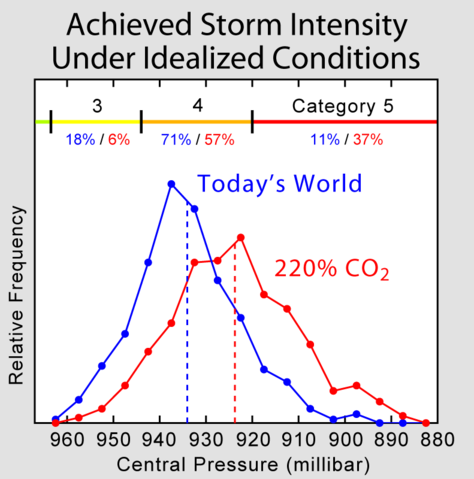Image:Hurricane Intensity Shift.png
From Wikipedia, the free encyclopedia

Size of this preview: 474 × 479 pixels
Full resolution (791 × 800 pixels, file size: 35 KB, MIME type: image/png)
Description
This figure, which reproduces one of the key conclusions of Knutson & Tuleya (2004), shows a prediction for how hurricanes and other tropical cyclones may intensify as a result of global warming.
Specifically, Knutson & Tuleya performed an experiment using climate models to estimate the strength achieved by cyclones allowed to intensify over either a modern summer ocean or over an ocean warmed by carbon dioxide concentrations 220% higher than present day. A number of different climate models were considered as well as conditions over all the major cyclone forming ocean basins. Depending on site and model, the ocean warming involved ranged from 0.8 to 2.4 °C.
Results, which were found to be robust across different models, showed that storms intensified by about one half category (on the Saffir-Simpson Hurricane Scale) as a result of the warmer oceans. This is accomplished with a ~6% increase in wind speed or equivalently a ~20% increase in energy (for a storm of fixed size). Most significantly these result suggest that global warming may lead to a gradual increase in the probability of highly destructive category 5 hurricanes.
This work does not provide any information about future frequency of tropical storms. Also, since it considers only the development of storms under nearly ideal conditions for promoting their formation, this work is primarily a prediction for how the maximum achievable storm intensity will change. Hence, this does not directly bear on the growth or development of storms under otherwise weak or marginal conditions for storm development (such as high upper level wind shear). However, it is plausible that warmer oceans will somewhat extend the regions and seasons under which hurricanes may develop.
This work also suggests that the smaller changes in sea surface temperature occurring over the last century are unlikely to lead to detectable changes in the intensity of hurricanes. Despite this, some authors have reported apparent changes in the frequency and intensity of tropical storms (Webster et al. 2005, Emanuel 2005), though it is unclear if such changes can be attributed to global warming.
Copyright
This figure was prepared by Robert A. Rohde and closely follows a figure prepared by Knutson & Tuleya (2004). It is claimed that closely reproducing aspects of their figure for the purposes of discussing the conclusions of their work qualifies as fair use under United States copyright law. The unique elements of this image are released under the Global Warming Art license described below. Reusers of this image should consider whether their intended use would also meet the standards for fair use.

Aspects of this work are copyrighted and unlicensed. It does not fall into one of the blanket fair use categories listed at Wikipedia:Fair use#Images or Wikipedia:Fair use#Audio_clips. However, it is believed that the use of this work to discuss the effects of global warming:
- To convey key research results
- Where no free equivalent could be created that would faithfully represent those conclusions
- On the English-language Wikipedia ( ), hosted on servers in the United States by the non-profit Wikimedia Foundation ( ),
qualifies as fair use under United States copyright law. Any other uses of this image, on Wikipedia or elsewhere, may be copyright infringement. See Wikipedia:Fair use and Wikipedia:Copyrights.
| Image from Global Warming Art This image is an original work created for Global Warming Art. Permission is granted to copy, distribute and/or modify this image under either:
Please refer to the image description page on Global Warming Art for more information |
References
- Knutson, Thomas R. and Robert E. Tuleya (2004). "Impact of CO2-Induced Warming on Simulated Hurricane Intensity and Precipitation:Sensitivity to the Choice of Climate Model and Convective Parameterization". Journal of Climate 17 (18): 3477-3494.
- P. J. Webster, G. J. Holland, J. A. Curry, H.-R. Chang (2005). "Changes in Tropical Cyclone Number, Duration, and Intensity in a Warming Environment". Science 309 (5742): 1844-1846.
- Kerry Emanuel (2005). "Increasing destructiveness of tropical cyclones over the past 30 years". Nature 436: 686-688.
File history
Click on a date/time to view the file as it appeared at that time.
| Date/Time | Dimensions | User | Comment | |
|---|---|---|---|---|
| current | 19:19, 4 April 2007 | 791×800 (35 KB) | Dragons flight ( Talk | contribs) | (reverse orientation) |
| revert | 20:47, 9 October 2006 | 700×708 (31 KB) | Dragons flight ( Talk | contribs) | (== Description == History of recorded tropical storm tracks showing the major storm forming basins and land areas vulnerable to major storms. This figure, which reproduces one of the key conclusions of Knutso) |
See the setup instructions for more information.